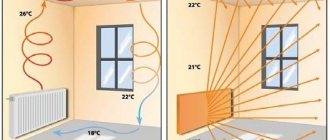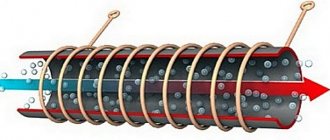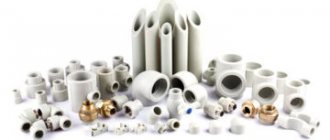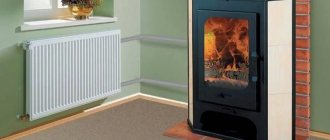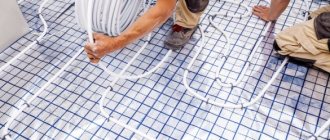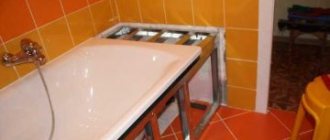New technologies for designing heating systems for low-rise private houses use several options for connecting all elements into one system. But no matter how advanced the technology, it is still impossible to bypass assembly using threaded connections in construction.
Crane groups, connections to heating registers and distribution units, all these points are connected using threaded connections. And if welding or soldering pipes allows you to create a reliable connection without the use of sealants, then if there is a thread, you cannot do without a sealant. And which seal to choose for installation is not as easy a question as it seems at first glance.
Eliminating leaks at pipe junctions
To repair a heating or plumbing plastic structure, a minimum number of tools is required. Any property owner can study information on how to fix a plastic pipe leak at a joint and easily complete the job. The main thing is to choose the best option for troubleshooting and eliminate it in the shortest possible time.
The first thing that should be done when repairing a water supply system is to stop the water supply to the entire system or to a separate area where there is a leak. The flow should be shut off before the leak appears. If the system is multi-circuit, turn off the liquid supply to the circuit being repaired and close the diverter valve in a local section of the water supply structure.
Then they only begin restoration measures. Next, the optimal method in this situation is selected to eliminate the leak at the junction of polypropylene pipes. The main criteria in this case are the elimination of the accident in the minimum time and the elimination of the hole or crack formed with the highest quality possible.
Pipe connection is leaking
Leaks at pipe joints can be eliminated using the same homemade or factory-made clamps. If there is a difference in diameter, you can first wind the rubber band and then make or put on a clamp.
If the connection is threaded and drips from under the winding, you can pour alcohol onto the tow and then spread it with BF glue. It is alcohol soluble. Once on the alcohol-contained tow, it liquefies and can flow into the joint. Then, when the alcohol evaporates, the glue dries, and the “drops” stop. But this method only works if you have “drops” and not a “fountain”. And one more thing: such a processed connection is then very difficult to disassemble.
If it is possible to stop the system or disconnect the radiator (if there is a leak at the junction with it), it is better to repack the threaded connection. To do this, carefully and slowly unscrew the nut (lock nut). It needs to be turned away and then wrapped. Don’t make significant efforts - there is a high chance of breaking it, and then you will definitely have to stop the system and redo everything. After tightening the nut, remove all the tow or fum tape, remove any remaining sealant, and in general, thoroughly clean the threads. Wipe it until clean, you can treat it with a degreaser (acetone or pure gasoline).
If it leaks under the locknut, it can be repacked
Please note that there is no excess tow - just a little, and paste on top. Take the winding and paste (sealant), wind the flax and coat everything with paste
Now you can twist it. First with your hand, then with a key. But here you also need to work carefully: it’s very easy to break the thread. Therefore, hold the key not by the edge, but in the middle - it’s easier to calculate the effort. Don’t overdo it with the amount of tow either. If cast iron, in principle, does not matter how much winding you wind, then aluminum and bimetallic, as well as steel, can crack from a large amount. A microcrack first appears in the collector, into which water leaks. The metal corrodes, the paint swells, a section (or the entire radiator) is damaged
Take the winding and paste (sealant), wind the flax and coat everything with the paste. Now you can twist it. First with your hand, then with a key. But here you also need to work carefully: it’s very easy to break the thread. Therefore, hold the key not by the edge, but in the middle - it’s easier to calculate the effort. Don’t overdo it with the amount of tow either. If cast iron, in principle, does not matter how much winding you wind, then aluminum and bimetallic, as well as steel, can crack from a large amount. A microcrack first appears in the collector, into which water leaks. The metal corrodes, the paint swells, a section (or the entire radiator) is damaged.
But this is all in cases where the threaded connection is leaking. If a fitting under a press (metal-plastic pipes) has leaked, you can try to simply tighten it. In the case of copper pipes, only soldering will work. If there is a leak at the junction of polypropylene pipes, there is also only one option - cut out the damaged piece and weld a new one.
It doesn't matter what you use. The result is important
Rules for choosing a material to solve a problem
When the cause of the pipe damage has been established, it is necessary to look for acceptable repair methods. There are several of them. Only most are suitable for low water pressure in the water supply circuit or heating system.
If you don’t have such a device at hand, then any piece of rubber (for example, from a bicycle inner tube) and wire or something similar will do.
But other methods of eliminating leaks when it comes to heating or hot water supply systems are unlikely to work. Thus, often used cold welding and special sealants are not relevant for wet surfaces.
Other instantly hardening composites (epoxy resin, dichloroethane) are also excluded, since they can be used on dry and disconnected water supply routes.
Minor leaks in the pipeline can be repaired on your own. But this will only be a temporary measure. At the end of the heating season, it is recommended to carry out major repairs so that the system no longer fails.
The first signs of a pipeline leak
In most cases, leaks in utility lines are immediately noticeable. After all, puddles appear on the floor and other structural elements of the building. However, minor leaks are not always so obvious.
Heating pipe is leaking
If the leak is small, it can be determined by the following signs:
- PP pipes become wet;
- drops that look like dew appear in the area of the fittings;
- the pressure in the pipeline system drops sharply.
If any of the above situations occurs, the owner of an apartment or house needs to pay attention to the water supply network. Perhaps it's time for a renovation.
A leak that is not eliminated, even in the form of a small trickle of water, will cause irreparable harm. Moisture can get on electrical appliances, penetrate electrical cables, or ruin just-completed renovations for neighbors on lower floors.
Preparation and necessary tools
Before repairing a pipe, the water supply must be shut off. Wipe off any escaped water and prepare the necessary materials and tools:
- “grinder” or hacksaw for metal;
- gas and pipe wrenches;
- coupling;
- putty or special tape.
This method involves replacing the damaged communication area with a new one, so you will need to buy a pipe with the same diameter as the old one.
How to take measurements to install a new site
Instructions for eliminating leaks
A more complex and reliable way to fix a leak is to replace the broken area. To do this, you must perform the following sequence of actions:
- Using a grinder, cut off the damaged section of the pipeline, taking into account a distance of 30 cm in both directions.
- Unscrew the threaded connection of the pipeline located adjacent to the leak.
- Using a gas wrench, hold the end of the cut pipe and cut the thread.
- Screw the coupling onto the machined end.
- Measure how long the new pipe should be, taking into account the threaded location.
- Thread the new pipe section at both ends.
- Apply putty to the threaded sections of the section to seal them.
- Connect the new section of the coupling, holding it with a pipe wrench.
Pipe replacement
Thus, there are several simple and quick ways to fix a leak. However, we note that all of the above methods will only help temporarily eliminate the problem. In any case, you need to contact specialists.
Damage troubleshooting
- On a straight plot.
- At the places where pipes meet (how to connect PVC pipes for water supply is written on this page).
- At the junction of individual radiator cells.
The risk zone is considered to be welded joints, insertion points of heating equipment and hidden sections of communications.
All these points need to be checked visually, and only then, with the circuit turned on.
A small fistula or even the smallest gap can be detected with a piece of ordinary toilet paper.
It absorbs moisture well and quickly, and thus you can see a hole in the pipe or at the junction of its sections (read how to properly connect HDPE pipes in this article).
This will only take a few seconds.
But what to do if this method turned out to be ineffective and you were unable to identify the fistula?
You continue to look for obvious signs of depressurization in the system, which manifest themselves as follows:
- large differences or lack of pressure,
- high level of humidity in the room,
- heating units are in good working order.
In this case, there is a way out of this situation, this is a pressure gauge. With its help, they determine how stable the pressure in the line is (one by one, check all its individual sections).
Please note! The leak must be sealed taking into account the entire period of operation of the system. Major repairs of the main line can only be carried out at the end of the heating season.
Advice you should heed!
In order to properly seal the gap in the heating system, you need to discharge water from the riser. Otherwise, a large amount of hot and dirty water will spill onto your floor.
Requirements for sealing materials for heating systems
The first thing that needs to be done if the tightness of the heating system is broken is to eliminate the coolant leak, thoroughly or temporarily - before major repairs are carried out. And the main thing that needs to be ensured when installing heating is its reliable tightness.
The listed factors determine the requirements for sealants used in the installation and repair of water heating systems:
- ease of use;
- heat resistance;
- high adhesion and strength;
- fairly rapid achievement of a sealing effect;
- safety of use.
What difficulties may arise
During repair welding of water pipes using electric welding, the quality of the seam from contact with water will be low. This repair of defects is a temporary measure. It is not provided for by GOST. When water pressure increases and the system is pressurized, the seam formed during welding can crack. Not all welders undertake this type of work. Surfacing of metal in the damaged zone often leads to multiple fistulas around the welding zone, because during welding the oxidation process is activated by contact with water. Instead of one fistula, many are formed.
Welding a pipeline containing water is a technologically complex job for a number of reasons:
- Due to the steam generated from the water during welding, you have to periodically wipe the mask; the work area is difficult to see.
- Water constantly cools the welding working area and prevents the metal from penetrating to great depths. Setting occurs immediately and crystallization begins.
- When pipelines located under the ceiling leak, work clothes get wet from the water. This is fraught with breakdown of current. The hand twitches and the electrode gets stuck.
What to do if a pipe or riser in an apartment bursts, where to go, who is to blame
This is the problem: I live on the 8th floor of a 9-story building, the neighbors from above did not use the sewer pipe, or rather, they bought an apartment there not long ago, before that there was no one there! As it turned out, my pipe was cracked, and they drowned me for about 2 days... because I couldn’t find them at home... when I came home from university they were no longer at home. After much quarreling, they finally agreed that it was their problem, so the plumbers at home told me that it was their pipe. In the end, they themselves found a person who made all the robots with cement and wrapped a bandage around the pipe; they didn’t want to replace the pipe! Water no longer pooled in the toilet. After 5 months, the downstairs neighbor appears, saying she has been gone for a year, and the walls and ceiling in the toilet are crumbling, and water is still dripping. As it turned out, my pipe was leaking just above the crosspiece, I didn’t see it and didn’t know about it, the neighbors built the pipe before it, they didn’t touch it... although it was burst below, there was no noticeable leak there then.
What to do in this case? To clean the riser, the following can be used: At a small (up to 2 - 3 meters) distance from the nearest revision to the place. First, measure the size of the pipe in the toilet from floor to ceiling. Please note that the old pipe should protrude from the ceiling and floor.
You hardly pay attention to the plumbing if it works smoothly. But you become wary if the toilet starts to leak or make unusual sounds. And there is every reason for this, because a leaking toilet is a serious thing, it can cause a lot of trouble not only for you, but also for your neighbors below. To avoid having to explain yourself about flooding, you need to regularly check the performance of your plumbing.
No one is protected from minor everyday problems and unpleasant surprises that plumbing supplies periodically present. In this article we will try to figure out how and with what to seal a leak in a sewer pipe. Useful: where special reliability is needed, cast iron sewerage is stamped with a graphite seal. Asbestos fiber with graphite, unlike bonded fiber, is not biodegradable and lasts for decades.
WATCH THE VIDEO ON THE TOPIC: Sewer smell in the apartment. What is the reason? / Sewage smell in the apartment
In this article we will try to figure out why the toilet is leaking and how to eliminate leaks in the most common cases.
Please note: pouring hot water down the toilet is never a good idea. The toilet bowl may simply crack due to a sharp change in temperature, unable to withstand the internal stresses that arise from local heating. Or if the rubber cuff between the toilet and the plastic drain leaks?
Or if the rubber cuff between the toilet and the plastic drain leaks?
Good afternoon, the question has become that condensation has started to accumulate heavily on the cold riser between the ceiling with the neighbors above, everything is dry with us, it’s already dripping from the ceiling, their riser is dry.
Everyone is familiar with the situation when plumbing begins to fail, and you don’t know what to do - buy a new one or repair the old one. The most unpleasant thing is when the toilet leaks. In order to take urgent measures, you should find out the reasons for this phenomenon. We will tell you how to do this in our instructions.
Effectiveness of sealants against leaks
Sealants are good connectors for sealing leaks in pipes. Experienced engineers claim that if the sealing rules are followed, it is possible to seal cracks with sealant in 90% of cases. However, the use of the product must be justified from an economic and engineering point of view. For example, if you know the location of the crack and have access to it, then it is recommended to repair it by welding.
Another example: a leak occurred due to the formation of a large hole in the system - in this case, the use of sealant is inappropriate, since it only seals small cracks.
How does the pipeline material affect the solution to the problem?
Metal pipes are distinguished by their enviable resistance and durability. Almost their only drawback is their susceptibility to corrosion. This is often what causes a leak in the circuit.
Less commonly, other pipelines also fail: plastic, polypropylene (mainly in places of threaded or fitting connections).
It is enough to compress the plastic pipe in the problem area, and all manipulations can be carried out under water pressure. The main thing is not to overdo it with the screed, otherwise the plastic will crack, and then you will have to replace the entire pipe.
A polypropylene pipeline can be easily repaired by soldering a separate fragment; a metal-plastic pipeline requires inserts. In the latter case, if the damage is not extensive, wrapping with electrical tape or treating with an adhesive (polyurethane, epoxy) will be sufficient.
Where to call if a pipe is leaking
In the event of a break in the water supply, heating or sewerage lines, you must contact the Housing Office to call a plumber (locksmith), or the emergency service. The telephone numbers of service organizations can be found in the help desk, on the notice board at the entrance to an apartment building, or on the receipt for utility services.
If a leak occurs on a weekday during business hours, you need to call the housing office, the management company, or directly the plumber assigned to a specific residential area. During non-working hours, at night or on weekends, you should contact the emergency service of the water utility. They will not do the work for the management company’s specialists, but they will come to the site and turn off the water in the heating, water supply or sewerage system until the housing and communal services specialists arrive.
Best answers
Yaoza:
Here! There can be problems just because of the sewer pipe! The neighbors downstairs are so sick of me that I keep filling them up and filling them up. First I changed the water supply pipes - they complained. Then it was time for the sewer system - but they didn’t want to change their tee (the one between the floors, into which my horizontal pipes and the riser itself go), I just changed the pipes, inserted a new one into the old sewer tee. And it turned out that it was precisely this that was leaking - there was a crack between the floors. That's where it leaked. Then they had to change this tee anyway. Of course, the water in the sewer does not constantly flow, but when the upper floors are lowered, the water flows down + the circular centrifugal movement of water inside the pipe - that’s what happens. that it gets into the crack of the pipe.
Galina Nikitina:
After our renovation, water also flowed down from us, and when our neighbors from above drained the bathtub. It turned out that some kind of thing like a tray was not installed in our toilet... They did it - and there are no problems.
Winds:
Canal water riser (for example, the junction of the outlet channel to the toilet may be poorly sealed, and with high pressure of water from the bathtub or when flushing the tank) it may end up on the neighbors’ ceiling. You must clearly describe (or take a photo) the projection of the leak..
when chipped in channel. riser - water can gush out of the fistula onto the wall and flow down.
Romance:
Our neighbors also accused us more than once of drowning them, they even came from the zhek, I’m not saying we’re dry here, but they mean it’s dry, but damn.. . how dry it is if the neighbors are still dripping. I personally climbed under the bathtub and checked in the toilet - it was dry! I sent it to the neighbors above, but no one listened to me. They drowned us more than once and the water has already done its job, finding new passages
647 acc:
The problem could be in the sewer pipe! ! !I live in a five-story panel Khrushchev building, there are 20 apartments in the entrance, our riser is adjacent to 10 apartments. In apartment 62 on the first floor there was dripping from the ceiling, we live in apartment 67 on the second floor. The cast iron sewer tee between the floors was leaking. The mechanic from the housing department replaced him in three apartments at once: in ours, 66 and 62. After his replacement, everything became normal. And before that, the neighbors from apartment 62 also came to us saying that we were drowning them, but ours was dry.
Are her boners dry? The fact is that water can flow from the floors in its ceiling, neatly flowing down the risers. Have you checked this? The plumbers from your housing department are simply too lazy to look, there are never consequences without a reason. Well, or a cold riser leaking in the ceiling... That the leak is in the ceiling is already a 100% option.
Raffi Baghdasaryan:
Cold water supply, hot water supply and sewerage pipes pass through the floors in floor slabs, in hot water supply and hot water supply sleeves, this is according to SNiP. Due to the negligence of builders, sometimes they pass without sleeves and when they come into contact with concrete, the pipes quickly rot. If the floor slab is hollow, then water can pass through the hollow and seep further from the riser. As for sewer pipes, there may be a crack in the passage through the ceilings, which is also the cause of flooding.
Eliminating leaks at the junction of a cast iron pipe
If a sewer pipe made of cast iron is leaking at the junction, you can fix the problem using:
- cement mortar;
- lead cones.
In both cases, the work procedure is the same and consists of the following steps:
- All unusable residues (residues of cement screed or lead) are removed from the joint;
- the junction of cast iron pipes is cleaned of dirt and corrosive deposits, and then dried with rags;
- if lead is used to seal the joint, then new cones are placed in the resulting hole and then covered with cement mortar prepared in a ratio of 1:10 (10 parts of cement are needed for one part of water);
- procedure for sealing a joint without lead:
- prepare cement mortar and a regular medical bandage;
- the bandage is dipped in the solution and placed in the hole between the pipes;
- The final filling of the connection is made.
Sealing the joint of a cast iron pipe
It takes approximately one day for the cement to dry completely.
What type of sealant can you choose?
Heating system elements can be connected in several ways. They can be securely fastened by welding, but in this case there is no possibility of disassembling the structure if necessary. The use of flange connections is not always convenient and is more common when installing heating plant elements. The most popular is the threaded connection, which is the easiest to assemble, but necessarily requires the use of seals, which can be divided into several categories based on their composition:
- Solid, including various washers and rings;
- Elastic, made from fabrics or threads;
- Liquid or viscous compositions.
Each type of sealant has its own advantages and features of use.
How to repair a fistula in plastic and metal pipes
Any IC (engineering system) of water supply and heating can leak. When it is not possible to immediately replace a section of a water pipeline, you need to know how to eliminate a fistula in a water pipe; most often, deformation appears in the bathroom; plastic pipes are characterized by:
- The pipes were installed under water pressure.
- Polypropylene fitting, not sealed.
- The structure is swollen.
- The water supply system is crumpled.
Fistula repair, polypropylene material:
| Way | Action |
| Welding | Cut the damaged piece of pipe, prepare the fitting and workpiece. Using a plastic soldering iron, melt the ends of the fitting and pipe and connect the melted ends. You should work “quickly”, remembering that the plastic hardens quite quickly, so it won’t be possible to redo it; you need accuracy and precision in your actions and work skill. |
| Threaded connection | Prepare an insert of the required size, cut a thread using a tape measure on a plastic pipe, then fasten the structure using a coupling. |
Repair of metal pipes is carried out in the following ways:
- Adhesive bandage. Technology: a medical bandage soaked in an adhesive solution is wrapped around the pipe 5-6 times, coated with epoxy glue, and a clamp is placed on top. Instead of a bandage, you can use fiberglass. The system is filled with water only after the adhesive has completely dried.
- Using a screw. Technology: the hole is widened, a thread is cut, a screw or self-tapping screw is screwed in. It is well used in minor damage; it cannot be used on an old pipeline, on a “decrepit” pipe.
- Cold welding agent. Technology: prepare the required amount of substance and apply to the damaged area. This leak fix is temporary. The “cold welding” substance loses its properties under the influence of hot water.
How to fix a leak and solutions
How to repair a leak in a heating pipe depends on where it occurred: at the junction of sections, at the connection of the radiator with the pipe, on the pipe itself. Repairs are carried out in different ways, let's look at the main methods.
Heating pipe is leaking at the junction
Cold welding
As a rule, it is used at the junction of two battery sections and helps to temporarily close the damaged area. It is made using adhesive-sealant, which can be purchased at a hardware store. It has a special composition that crystallizes when it dries and fills the hole.
Applying “cold welding” to a metal pipe
Procedure
:
- thoroughly clean the damaged area from paint and rust using a brush with metal bristles or sandpaper;
- degrease, alcohol, solvent, acetone are suitable for this;
- cut off a piece of sealant, knead with wet hands until smooth;
- press well into the damaged area on the heating radiator and smooth it out;
- until the composition hardens completely, it must be pressed tightly to the surface;
- Curing time is approximately 20-25 minutes, complete polymerization is after 3 hours.
Cement-plaster cast
If a hole is found on the heating pipe or the junction of the battery sections, you can make a cement-plaster bandage; for this, prepare the following consumables:
- medical bandage, a piece of gauze or thin cotton fabric;
- alabaster (plaster);
- cement;
- bucket or basin with water.
Repairing a leak with a cement bandage
Procedure
:
- dilute cement in water, mixing it with gypsum, the consistency should be like that of rich sour cream;
- take strips of fabric or bandage 25-30 cm long, soak in the resulting composition;
- wrap a cloth around the damaged section of the pipe;
- overlays are made until the bandage is strong and tight.
Application of clamp and rubber
If you notice a heating pipe leaking, you can apply a commercial or homemade clamp, as well as a rubber lining, as a temporary measure. If there is a factory-made clamp of a suitable diameter, it must be applied to the leak and secured tightly with a bolt. If you don’t have one on your farm, you’ll have to make the rubber pad yourself.
Procedure
:
- cut a rectangle from a piece of rubber that will be 2-3 centimeters wider than the hole, the length should be the same as the diameter of the pipe;
- wrap the cover tightly around the pipe, and secure the edges with wire or metal clips; you can make a wire winding along the entire length of the bandage.
Repairing leaks with rubber and a clamp
Welding Application
If a heating battery (not metal-plastic, but cast iron) is leaking in a house or apartment, welding will help eliminate the defect. It can be used anywhere on the radiator. Therefore, after you have made minor repairs yourself or shut off the water supply to the battery, call the emergency service or a private company that provides hot welding services.
Repairing a metal heating pipe using welding
How does the pipeline material affect the solution to the problem?
Metal pipes are distinguished by their enviable resistance and durability. Almost their only drawback is their susceptibility to corrosion. This is often what causes a leak in the circuit.
Less commonly, other pipelines also fail: plastic, polypropylene (mainly in places of threaded or fitting connections).
Metal pipes are the most difficult to seal, since electric welding is not applicable to them. After such exposure, corrosion processes only become more active.
It is enough to compress the plastic pipe in the problem area, and all manipulations can be carried out under water pressure. The main thing is not to overdo it with the screed, otherwise the plastic will crack, and then you will have to replace the entire pipe.
A polypropylene pipeline can be easily repaired by soldering a separate fragment; a metal-plastic pipeline requires inserts. In the latter case, if the damage is not extensive, wrapping with electrical tape or treating with an adhesive (polyurethane, epoxy) will be sufficient.
Repair methods
Repairing a heating pipe without draining the water is only possible temporarily. In the summer, the water from the system will need to be drained, then the crack will need to be sealed. You may have to completely replace the area with the damaged liner with a new pipe.
There are several ways to repair this type of breakdown. Each of them requires basic knowledge and skills:
- method using chemicals;
- working with a welding machine;
- mechanical method, where various metal fasteners are used in the form of a clamp and bandage.
Required tools and materials
For work you will need the following locksmith tools:
- sealant, epoxy resin and glue;
- rubber band and elastic gaskets for fittings;
- welding machine and electrodes;
- pliers, wrenches, steel wire and plumber's tape.
It is also worth stocking up on clamps of the required diameter and choosing a bandage. When working with chemicals, it is recommended to wear rubber gloves.
On a running system
You can fix a leak in a heating system full of water in the following way:
- If the crack has a small, almost invisible diameter, then chemical agents can be used. Before applying active substances to a metal surface, it must first be cleaned with sandpaper. Then soak a bandage or cloth in a chemical and apply it to the damaged area.
- You can use cold welding or make a bandage from a plaster-cement mixture. During such work, water is not drained from the pipes, but the pressure level in the heating system must be reduced.
- If the leak is located in places with threads, then it is recommended to simply replace them completely or partially, as in the case of damage to the fitting or clamp.
On a stopped system
You can independently and completely repair a damaged heating system only if it is in shutdown mode. Then, in order to eliminate damage, it is allowed to use any electrical tools and replace metal pipes.
When carrying out repairs, you should always follow safety precautions and, most importantly, correctly assess the nature and extent of the damage. This is necessary in order to make a competent and correct decision to eliminate them.
Source
Classification
This material can be single-sided or double-sided and can be used to work in different temperature conditions and with different materials. Before purchasing tape for specific jobs, read the instructions for use. Insulating tape for sealing water pipes comes in the following types: butylene, bitumen-polymer, roofing and polycarbonate.
Tapes of various classes can be used not only during construction and repair work, but also when working with vehicles, in the oil and gas industry, and is also used in domestic conditions. This material can be used both to eliminate leaks and when installing electrical networks to create a waterproof layer.
Joint sealing tapes
In cases where it is necessary to ensure a high-quality connection of a thread or flange, in addition to the use of surface tape, internal plumbing tape is used. It is thinner and has other technical and operational properties. Such sealants include the brands “K-Flex”, “FUM”, “Record”. There is also a special composition in the form of a gel, which allows for additional compaction and sealing of connections.
Thread sealers can be used to work with pipelines of various classes. They help eliminate leaks of natural and liquefied gas, drinking and industrial water, and various antifreezes. They are used by plumbers, gas workers and even car mechanics.
Thread sealing tape can be used in conjunction with surface insulation.
Butylene
This type of sealant can work in a wide range of temperatures - from -60 to +120 degrees Celsius. Butylene tape is suitable for repairing leaks in water pipes and when working with gas pipes. It consists of a butyl rubber mixture, so it has excellent contact with almost any material. It can also be used when working with polyvinyl chlorides. Butylene is able to withstand exposure to ultraviolet radiation, acids, alkalis and does not emit any odor.
Bitumen-polymer
An airtight material that can be used to seal imperfect, rough and uneven surfaces. This material not only provides high-quality sealing of seams and pipeline connections, but is also capable of sealing itself in case of damage. This feature allows the tape to be used to provide dielectric and anti-corrosion protection. It is also suitable for connecting joints, including connectors with flange and thread.
Fum tape
Explanation of the abbreviation FUM - Fluoroplastic Sealing Material. The most popular type of sealant for improving the sealing of water and gas pipes. Used inside threads, sometimes applied over joints. This pipe tape is distributed in the form of rolls of white color, resembling electrical tape, 1-2 centimeters wide. Fumka or fum tape is divided into several categories, depending on the technical characteristics and composition:
- for use in aggressive environments – withstands and withstands the effects of acid, alkali, natural and liquefied gas;
- for oxygen - since this gas leads to rapid corrosion, innovative compounds are used to seal oxygen-conducting pipelines that can withstand the aggressive environment of this chemical element;
- for domestic needs - withstands aggressive environments, which are not uncommon in a private home, produced for domestic use.
How does the sealing effect manifest itself?
You should not expect the leak to be eliminated immediately, but only on the 3rd or 4th day. During this time, the sealant for heating pipes will compact and close the cracks in problem areas from the inside. Eliminating the problem of coolant leakage will manifest itself in the fact that the sound of falling drops of liquid will no longer be heard in the house, moistened areas on the floor will dry out, and the pressure in the system will no longer decrease.
At the same time, one of the negative effects may be a slight blockage of passages in devices for distributing coolant flow, as well as in thermostats. But this problem can be easily solved by periodically opening and then adjusting these types of regulators to the desired position to prevent them from further sticking.
The video lesson will help you understand how to fix a leak in your heating system yourself using liquid sealant.
Based on all that has been said, you can be sure that liquid sealant is undoubtedly worth using to eliminate leaks in the heating system. Even though its price is steep. However, it should be understood that hidden installation of heating pipes is not only a convenience, but also a certain risk, for which you sometimes have to pay.
Heating radiator leaking
If you find a leak in the heating battery itself, you can plug the hole using a simple self-tapping screw. This is done to reduce the flow of water, which will make it easier to carry out subsequent repair work, even if the taps are not turned off.
If a hole forms in the joint of the heating radiator, the problem is eliminated using a piece of fabric glued with epoxy. They wrap it around the damaged area. The leak has been fixed and you can rest easy until the end of the season.
By using a thick piece of fabric, electrical tape, tape and salt, you can also eliminate a leak in the heating battery:
- pour salt onto a cloth and wrap the damaged area;
- We secure everything with tape.
If the leak is not found, you should temporarily turn off the taps of the heating system, remove the battery, and lower it into a container of water. Then we determine the damaged area by the place where the air passes through. A sealant is used for repairs. After filling the damaged area, we additionally apply a fabric wrap and attach the heating radiators back.
Typically, at the top of the heating radiator there are air release valves that can be used during its operation. After the end of the operating season, the heating radiator or its damaged sections are replaced with new ones.
If a section of the radiator is leaking, the same procedure is followed as for a radiator leak.
Radiators and heating pipes can be either plastic or aluminum; they are a little more difficult to repair, and special skills are required to eliminate leaks in them. If a cast iron battery leaks, then cold welding will be required to repair it.
It is necessary to worry in advance about the availability of the necessary materials for repairing the heating system, and to repair everything more thoroughly after the end of the heating season.
Getting rid of leaks with a bandage
A plumbing bandage is a piece of pipe, cut along the longitudinal axis and equipped with eyes for a screw tie. Bandages are made of durable metal - cast iron or aluminum, steel. Polymer bandages can be used to repair plastic pipes.
In welded structures, sometimes a seam running along the entire pipe begins to leak. In the initial stage of a leak, individual holes are almost indistinguishable to the naked eye. In this case, applying one or more bandages helps. However, a defective welded pipe should be replaced as soon as possible.
The disadvantages of the bandage are its high cost and low efficiency when sealing fistulas on an uneven surface. A hole that has rusted in the immediate vicinity of a poorly executed weld may not be closed tightly enough with a bandage. In this case, the leakage will resume after some time.
The main causes of leaks and their locations
The most common reason for damage to any steel heating pipe is caused by oxidation of the material, when a fistula appears in the pipe. From the inside, water is almost constantly in motion, but from the outside, the metal is often exposed to moisture, air and temperature fluctuations, which contributes to the rusting of the pipe. This is the reason for the appearance of a leak in the most vulnerable place of the heating system.
Many of you may be wondering whether polyethylene pipes leak, because they do not oxidize like steel pipes. Naturally, in this case, the chance of leaks occurring is much less - the reasons for their occurrence will be of a slightly different nature. For example, heating pipes made of polypropylene and polyethylene may leak if they are incorrectly selected, that is, if they are used for other purposes.
This problem often arises among people who, for a number of reasons, decided to save money when building a heating system. Quite often, people buy PP pipes for cold water, which is a gross violation. The fact is that under the influence of high temperature, pipes undergo deformation, swell or burst. This in turn can greatly damage your home and your neighbors. As a result, there is no need to talk about any savings; on the contrary, at the end of the heating period, a significant part of the system will need to be replaced.
However, such a problem can arise even for those craftsmen who decide to use metal-plastic pipes for heating systems. In fact, even such heating pipes leak, and again the problems will need to be solved quickly so as not to harm anyone.
As a rule, the heating pipe leaks in the following places:
- on a flat section of the pipeline;
- in places where pipes are joined (on fittings or threads);
- at the junction of pipe sections.
Based on where the heating pipe leaked, the sealing method will be determined.
Types and characteristics of threaded connections in the heating system
Today, when installing almost all heating systems, both new types of connecting elements and traditional options, where threads are cut on steel pipes, are used. Each type of carving has both positive aspects and disadvantages.
To choose the right seal, it is worth considering all the elements in more detail.
Cast iron radiators
For connection, both modern options are used in the form of fittings with American females, and traditional ones in the form of pipe bends on couplings with locknuts. The thread in the cast iron body of the radiator nut has chips and irregularities, and can also be cut at an angle, which complicates the selection of threads on the fitting. In this unit it is necessary to use a sealant that will ensure reliable filling of all voids along all thread turns.
Drives and couplings
Threaded connections of pipes and couplings also have their disadvantages. During work, the thread is cut with a margin of 3-4 turns, while the pipe profile itself may have significant deviations. Simply put, it may not be round, which is why the threads are of different depths and profiles - from triangular with an acute angle to trapezoidal. A nut and coupling made of cast iron may also have thread defects in the form of chips, broken threads, different heights and depths of threads. Such a connection requires that the seal not only fill all the cavities, but also be elastic - when screwing a cast iron coupling onto a rigid seal, it can simply burst.
Fittings with American women
Fittings with American females produced by well-known manufacturers of shut-off and connecting valves have standard threads made in accordance with high quality standards. At the same time, this threaded connection also requires sealing since the thread most often has great depth and clear edges.
Installation of the clamp
Special plumbing clamps are also not free from shortcomings. The rubber gasket included with the clamp is usually thin. To ensure that a fistula is eliminated in a water supply or heating pipe, equip the clamp with a porous rubber gasket. You can use a car or bicycle inner tube, a micro-shoe shoe, or an insulating mat.
It is not always easy to purchase large diameter clamps. However, many models of screw clamps can be easily disassembled and connected into one clamp of the required length. The prefabricated clamp holds the tension almost as reliably as a single clamp.
The clamps used in aviation for attaching all kinds of pipes to the ends of metal pipes are of the highest quality. Their coverage around the perimeter of the pipe is uniform, the tightening is reliable and is often carried out without the use of tools. Such clamps are expensive, but easy to use and almost eternal. Unfortunately, not every model of aircraft clamp opens for easy placement on a water pipe.
Mechanical methods of pipeline repair
These methods are quite numerous, since craftsmen successfully use various available materials.
Medical bandage and cement
This is the simplest option if the “appearance” of the pipe is not nearly as important as its tightness. In this case, the operation consists of simple steps:
- first the bandage is cut into pieces, then a not too thick cement mortar is made;
- strips of material are thoroughly impregnated with the mixture, after which they are quickly wound around the damaged area.
The resulting cocoon is again coated with the solution, then left to dry. Such an almost “concrete structure” dries out in about a day. The finished patch is painted.
Help with self-tapping screws and bolts for metal products
This is another popular option when considering repairing water pipes without welding. It is suitable if the thickness of the metal walls is more than 3 mm, and the diameter of the hole that appears is no more than the same 3 mm (maximum 4 mm). The role of the “plug” is played by ordinary galvanized self-tapping screws, supplemented with a rubber washer. The operation is quite simple:
- The sections of the pipe near the hole are cleaned of rust with a file or sandpaper.
- Then a self-tapping screw is screwed into it. To facilitate the operation, use a screwdriver.
It is better to use a cordless tool. The fasteners must be selected so that the part of the self-tapping screw inside the water supply is minimal. It is clear that such repairs are still a temporary measure. To get more reliable protection, it is recommended to use a bolt. In this case, the procedure is different. First, a thread is made into the hole with several self-tapping screws, then a bolt, also equipped with a rubber washer, is screwed into it.
Some craftsmen believe that it is not always advisable to screw in bolts, especially if the case is an emergency. When the age of the pipe allows, the element can simply be driven in, but the hammer must be used carefully.
Using a rubberized metal clamp
This method is also used if the hole in the pipe is relatively small. A metal clamp is chosen with the same diameter as that of the damaged water supply section. If several leaks occur in one area, it is recommended to purchase a device of greater width.
The rubber gasket on it is a mandatory element, so it is better to immediately purchase just such a product. However, the seal can be made independently from a rubberized material whose thickness is at least 3 mm. The recommended width of a homemade gasket is 2-4 mm larger than that of a clamp. Length - 10 mm less than the circumference of the pipeline.
Using a temporary bandage
Such repair of water pipes without welding may be necessary if an emergency occurs at an inconvenient time, when it is not possible to do a quality job. This will help temporarily eliminate holes that are oblong in shape. In this case, first look for a suitable material for the bandage. It could be:
- bicycle tire;
- boot top;
- medical tourniquet;
- thick glove.
The main condition is that the size of the material is sufficiently large: it must completely block the flow. Such “temporary structures” are fixed with bolts and clamps.
Magnet for small leaks on metal
This method is quite original, but it is said that it still works if the hole diameter does not exceed 1 mm.
- The leaky area is processed with a file until smooth.
- Then a magnet is attached to it.
The method uses the properties of a magnet to collect metal particles present in tap water. As a result of its “attractiveness,” a metal plug is collected near the hole, which can reliably close the hole.
Let's summarize the information considered
A pipe leak is, of course, a rather unpleasant event. Especially if the water in it is under pressure. However, this cannot be called a disaster. After all, as they say, knowledge is power. The main thing for a home master is not to panic. And there will always be a couple of means to solve the problem in the house. No one is immune from such troubles, because it is impossible to visually see that a pipe will soon leak. We can only hope that if such a situation happens, it will not happen at night, when there is no one to notice it.
The situation is, of course, unpleasant, but not fatal.
We hope that today's article was useful and interesting to our dear reader. Perhaps someone still has questions on the topic. The Homius.ru editors will be happy to answer them. All you have to do is state the essence in the discussion below. If you have had a similar problem or know other ways to solve such a problem, please share your experience with novice home craftsmen. After all, such information is always relevant and in demand. And finally, we suggest watching a very exciting video on today’s DIY topic.
Watch this video on YouTube
Previous Engineering How to make money by installing a two-tariff electricity meter? Next Engineering Stainless steel sinks for the kitchen: all the pros and cons
Preventing Leaks
In order to prevent the formation of leaks in sewer, plumbing and heating systems, you should follow the simple recommendations of specialists:
- do not allow the drain pipeline to become clogged;
- make sure that condensation does not form on the cold riser;
- freezing of the external pipeline is unacceptable;
Each of the proposed solutions to the problem does not cause technical difficulties. The only exception is a malfunction of the metal or plastic system on the drains. In this case, simply covering up the damaged area will not work; this will require the help of specialists and the use of equipment.



